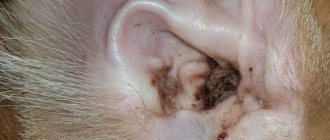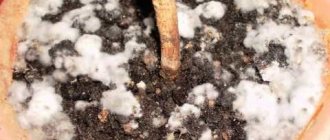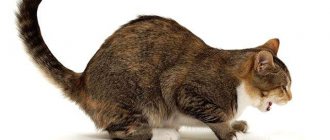Causes of itching in the head and neck area in cats
Cats scratch their necks until they hurt for a variety of reasons. This behavior is provoked by external factors, ectoparasites and a number of diseases of varying degrees of danger. The largest number of cases are due to allergies and insect parasites. A smaller percentage of the probability is associated with viral, autoimmune and other diseases.
Ectoparasitosis
Otodectes cynotis, or ear scabies, is caused by mites. They settle in the ears or ear canal and cause severe itching in the cat. As a result, she regularly shakes her head and scratches her ears until they hurt. It is transmitted by contact and affects mainly young animals.
Notoedrosis or pruritic scabies develops against the background of Notoedres cati tick bites. The disease is characterized by inflammation of the scalp, hair loss and severe itching. An infected cat constantly scratches its head until sores appear.
Important! Notoedres cati itches spread from cats to other animals and even humans. For some time they cause pseudo-scabies and then go away, since there are no favorable conditions for life.
Cheyletiellosis, or wandering scabies, is caused by Cheyletiella mites. The fact that a cat has these parasites is indicated by severe itching and fine dandruff. The disease often spreads to humans and causes an itchy rash.
Demodectic mange or ironworm is the result of exposure to mites of the genus Demodex. They develop their vital activity in the sebaceous glands and hair follicles. As a result, bald patches of skin and sores appear on the cats’ faces. The areas most commonly affected are the areas around the eyes and mouth, as well as the front legs.
Fleas are a common cause of scratching on the neck and other parts of the body. They parasitize primarily on cats and dogs. They can also temporarily transfer to humans. When infected with them, a large number of black crumbs appear under the fur of pets. These flea droppings are especially noticeable in the lumbar and back areas.
The animals themselves itch very much to the point of soreness, as they experience severe itching at the bite sites.
Allergies
A common reason why a cat scratches itself until it hurts is allergies. It implies an abnormal reaction of the body to a stimulus. When first hit, protective cells create an antidote and “remember” the allergen. And if it penetrates again, a violent reaction occurs in the body. It leads to inflammation, itching and other symptoms.
Allergies cause several diseases in cats:
- atopic dermatitis;
- flea dermatitis;
- food allergies;
- contact dermatitis.
Flea dermatitis
Flea dermatitis is a common reason why a cat scratches itself until it hurts. When one flea bites, it releases a special anticoagulant into the cat's skin. This substance prevents blood clotting. The pet becomes sensitized to it. And the body reacts to the bites of other fleas in the form of inflammatory processes, rashes and papules.
The affected areas are very itchy. The cat begins to behave restlessly and reacts nervously to touch. This type of dermatitis occurs in two forms: chronic and latent. In the first case, alopecia (foci of baldness) and nodules with flea feces develop on the body. The second is characterized by the appearance of papules with a red rim.
The cat begins to tear them apart until they hurt. Often secondary infection is associated with wounds.
Atopic dermatitis
The disease is typical for young animals aged 1 to 3 years. The main reason for its appearance is the uncontrolled selection of cats. As a result, animals develop allergies to dust and pollen. In this case, it is almost impossible to identify the allergen.
Important! Atopic dermatitis has no cure; cats will regularly scratch their skin until it hurts. The action of therapy is aimed at suppressing symptoms.
Dermatitis in cats manifests itself with the following symptoms:
- the appearance of dandruff on the withers and back;
- hair loss;
- labored breathing;
- discharge from the eyes and nose;
- cough;
- profuse salivation.
Contact dermatitis
This allergy is similar in symptoms to atopic dermatitis. It often manifests itself when the pet comes into contact with household chemicals, toilet filler, the hair of other animals, and flea products. Contact allergies are manifested by severe itching, flaking of the skin and a small rash. Often a cat itches until it hurts. And this increases the risk of secondary infections.
Food allergies
Allergens can accumulate in the body of animals. With their regular consumption, health problems begin. Food allergies are characterized by:
- the appearance of a rash on the cat’s neck and head;
- hair loss;
- the appearance of dandruff;
- inflammation of the eyelids;
- unpleasant odor from the mouth.
Important! Symptoms of food allergies in cats are often accompanied by vomiting and indigestion.
A common cause of food allergies is feeding cats salted, fried, smoked and other prohibited foods from the table. Mixed feeding with industrial feed and natural products also contributes to its appearance.
Seborrhea dry and oily
Veterinarians are still arguing about the causes of the disease, but to this day many cases must be considered idiopathic, since not a single study has helped to identify a single predisposing factor. In cats, the most common is the “fat” variety.
The clinical picture is quite characteristic. In addition to the unpleasant odor already mentioned above, numerous dandruff appears on the animal’s skin and fur (with the dry variety), or the cat’s tail resembles an unsightly icicle. In the latter case, this happens because the sebum released in incredible volumes simply sticks the hair together.
We suggest you read: Which cat litter is best to choose?
The intervals between relapses (with proper feeding and good living conditions) can reach several months.
The main predisposing factors are:
- Temperature changes, as well as keeping the cat in rooms with excessively dry air (which is typical for all apartments with central heating).
- It is believed that one of the main reasons for the development of seborrhea in many cases is a variety of allergic reactions.
- The same can be said about diseases of fungal etiology. Pathogenic fungi and yeast have a very bad effect on the condition of the skin.
- “Raw” or “oily” seborrhea is a common consequence of severe hormonal disorders. In particular, it often appears with problems with the thyroid gland.
- Obesity. Firstly, in cats it can also be a consequence of problems with the endocrine glands. Secondly, a “swollen” cat is simply physically unable to take proper care of itself, which makes it much easier for pathogenic fungi to invade its skin. In addition, in such cases, the animal may not have seborrhea, and greasy skin is only a sign of its extreme neglect.
- Diseases of the gastrointestinal tract. If the body does not receive the proper amount of nutrients, micro- and macroelements, the likelihood of developing any diseases becomes many times higher.
- Skin diseases of tick-borne etiology. As a rule, the activity of these parasites leads to the development of a dry type of the disease: mites, gnawing through the outer layers of the skin and actively developing in them, interfere with the normal functioning of the body.
Symptoms and treatment
The symptoms are quite specific, and therefore, as a rule, there are no particular difficulties in identifying the disease. First of all, it is the tail that is affected, which as a result either becomes covered with dandruff, or takes on the appearance of a “greasy icicle.” Abundant dandruff rashes can be found in places where the animal likes to rest; they also become heavily greasy in the case of the oily type of pathology.
Another characteristic sign is very specific, sharp and extremely unpleasant. Experienced owners or veterinarians are able to make a diagnosis as soon as they smell this “aroma.” Note that seborrhea itself does not produce any odor - it is a consequence of the activity of secondary microflora.
The following products have proven themselves to be effective:
- "Tea tree". It degreases the skin well and has a pronounced anti-inflammatory effect.
- Additionally, any antiparasitic shampoo. It is used in cases where the disease is caused by the activity of fleas, ticks, or other ectoparasites.
- Accordingly, when the disease is fungal in nature, shampoos with an antifungal effect are used.
Skin infections
Scratched cat sores on the neck and head in some cases occur due to infectious diseases. Cats with access to the outdoors are especially susceptible to them. When a bacterial infection of the skin occurs, one of two forms develops:
Animals with sensitive skin are predisposed to eczema. It develops through prolonged contact with flea collars, harnesses, after insect bites and skin parasites.
Important! Diabetes mellitus, neuropathy and hormonal changes contribute to the appearance of eczema.
A rash and blisters appear on the pet's body. Severe itching leads to the cat scratching its neck until it bleeds, and sores appear that do not go away for a long time. To eliminate eczema, antibacterial therapy, various ointments and powders are prescribed.
Viral dermatoses
Cat scratching on the skin is also characteristic of viral dermatoses. The herpes virus affects the eyes and respiratory tract of the animal, often manifesting itself as skin lesions. They are often localized in the area of the nose and eyes, less often on the paws and stomach.
Feline herpes is characterized by:
- bloody stains;
- small rash;
- swelling of the skin;
- small scabs on the neck, sores on the head.
Skin changes appear 1.5 weeks after the disappearance of conjunctivitis and other characteristic symptoms.
Cowpox or poxvirus is a rare disease. It can enter the cat's body through the bites of small rodents. It manifests itself as skin lesions in the form of nodules and small ulcers. With good immunity, it goes away on its own. In weakened animals there is a risk of developing a severe form.
Autoimmune dermatoses
Autoimmune diseases are characterized by an abnormal reaction of the immune system to its own tissues and cells. Skin manifestations on the body of cats are characteristic of several diseases:
Treatment
Treatment of cats suffering from itching should be aimed at the disease, one of the symptoms of which is itching. Treatment should be prescribed by a veterinary specialist at the clinic.
The course of treatment by a veterinarian is based on a special diet and the use of medications. Some medications can cause allergies in cats, so they must be given under the supervision of a veterinarian.
Medications for cats are prescribed depending on the type of disease.
In case of fungal infection of the skin, the veterinarian takes tests, based on the results of which he chooses a treatment regimen. Therapy is based on taking drugs from the griseofulvin group. Itching is relieved by using a topical antifungal agent.
Drug therapy for ringworm in cats:
Fungin (spray of the drug) is used externally. The active ingredients are clotrimazole and propolis. During treatment, the owner uses a cotton swab to treat most of the affected skin, including the border areas of healthy skin (no more than 2 cm from the lesion). This drug is used for 2 weeks 1 time per day.
Ointment Yam. Apply 2 times a day until the crusts begin to separate and new hair begins to grow. Due to the fact that this drug is potent, owners should not apply this ointment to the skin of the ears (it will cause burns).
Sanoderm ointment - used 2 times a day. The course of treatment is 2-4 weeks.
Antifungal shampoos with chlorhexidine and miconazole are used as therapeutic bathing. (Doctor; Synergy LABS; Alezan).
Cats suffering from ringworm are washed with shampoo once every 3 days for 6 weeks. When treating ringworm, medications containing sulfur, creolin and tar are used (Zoomicol, creolin, birch tar, sulfur ointment, epilconazole).
Vaccination is carried out simultaneously with therapeutic and preventive purposes.
When vaccinating cats against ringworm, veterinary clinics use antifungal vaccines such as Microderm, Vakderm F, Polivac. The use of these vaccines provides a high therapeutic and preventive effect. Vaccine injections are given 2 or 3 times with an interval of 14 days. In cats vaccinated with these vaccines, immunity develops by 25 days after vaccination. If a veterinarian has to vaccinate a cat for therapeutic purposes, then the vaccine is administered 5 times with an interval of 10-14 days.
When the sources of itching in a cat are flea bites , a number of drugs are used that have an effect on fleas: Rolf Club flea shampoo, Celandine Shampoo, Fitoelita Shampoo, Lugovoy flea shampoo, Mr. Shampoo. Kiss”, Shampoo “Bio Groom”, etc. Spray “Bars”. Flea powder “Flicar”, “Insectin”, “Clandestine”.
Today, the most effective medications for treating cats against fleas are considered to be drugs based on selamectin (Stronghold, manufactured by Pfizer Animal Health, USA), finpronil (Frontile, manufactured by MERIAL S.A.S., France), imidacloprid (Advantage, manufactured by Bayer, Germany).
When bathing, use a special shampoo, and then put on a flea collar.
If the source of the cat's itching is the presence of worms , it is dewormed. Veterinary pharmacies sell the following drugs for deworming cats: Panacur, Febtal, Dirofen, Pyrantel, Polyvercan, Prazitel, Profender.
For kittens, veterinary pharmacies sell special gentle medications that do not injure the kitten’s delicate gastrointestinal tract. These drugs include: milbemax, polyvercan, prazicide, pyrantel, dirofen suspension.
The veterinarian prescribes one of the drugs depending on the type of parasite identified during the examination.
When a cat is affected by scabies mites, veterinarians use.
For demodicosis the following medications:
Antiparasitic drugs of the invermectin series: ivermectin, baymecom, otodectin, amirtrazine, eprimek, ivomek, novomec, dectomax, cydectin, etc. These drugs are administered by subcutaneous injection. Preparations for external use - stomazan, butox, etc. Preparations that increase the body’s immunological resistance to parasites, by activating its protective functions and protecting the cat’s body from their re-introduction: immunoparasitan, gamavit, maksidin, Gala - vet, etc. To relieve inflammation of the patient’s skin the animal is prescribed anti-inflammatory and special medications for external use in the form of ointments, gels (pihtoin, sulfur ointment, sea buckthorn oil, Demos liniment, Ivermect gel, Amidel gel, Aversectin ointment, Sofroderm ointment, Cythioate ointment, others.). Special external sprays Acaromectin, Ivormectin, Cydema, Pirol and others. To treat affected skin with scabs, oil preparations of Amita, Ectodex, Tsipam, Mycodemicil, etc. are used. In their absence, simple oils can be used - sea buckthorn, flaxseed, olive. When using them, it is necessary that they are absorbed into the skin, preventing it from licking them off. To do this, the cat can be wrapped up. Skin application once a month between the shoulder blades of Stronghold or Advocate has a good effect. The course of treatment lasts 2-4 months.
Otodectosis. After cleaning, the affected areas are treated with acaricidal preparations (otoferanol, acaromectin, ivermectin, stronghold) by introducing a few drops into the ear canal. To ensure that the injected acaricidal drug is distributed evenly, we massage the auricle with our hands. The pharmaceutical industry produces a large number of acaricidal ear drops “Amit”, “Amitrazin”, “Dekta”, “Tsipam”, “Demos”, “Ektodes”, “Enacid-alpha”, “Dana”, “Mikodemotsid”, “Otovedin”, “Surolan”, “Otoferonol-gold”, “Otoferonol-plus”, “Otoferonol-premium”, “Aurican”, “Anandin-plus”. For ease of use, acaricidal drops are produced in pipettes - “Dana”, “Frontline”, “Fiprist”.
Notoedrose. In the treatment of notoedrosis, aversectin ointment is effective, which must be applied to the affected area of the skin twice a week. Liniment Demos gel, which is applied to the affected area once every four days, helps quickly get rid of ticks; the course of treatment consists of applying this liniment five times. When treating the disease, 0.1% aqueous emulsions of neocidol (diazinon), permethrin (stomazan), and 0.01% aqueous emulsion of butox are used. When treating a sick cat, these acaricidal drugs are used 2 times, with a break of 7-10 days. Stronhold (the use of this drug before 6 months of age is contraindicated), as well as other acaricidal drugs containing ivermectin and selamectin.
In case of an allergic reaction in a cat, antihistamines (diazolin, suprastin, diphenhydramine, tavegil, etc.) and glucocorticosteroids (dexamethasone, hydrocortisone, prednisolone, etc.) are used as symptomatic drugs to reduce histamine levels and eliminate itching and swelling.
Remove the allergen from the diet and carefully select a hair care product.
For an infectious disease (otitis, pyoderma, dermatosis), antibiotics, anti-inflammatory drugs, vitamins B and A, and immunomodulators are prescribed.
When using the ointment, put a collar or T-shirt on the cat so that it cannot reach the affected areas of the skin with its paws.
History taking
Diagnostics will help you understand why your cat scratches its neck and what caused the sores. But before carrying it out, the veterinarian needs to collect an anamnesis.
Age and breed
A kitten up to one year old is susceptible to skin and subcutaneous parasites. Young animals suffer predominantly from allergic reactions. If an elderly cat scratches its neck until it bleeds and hurts, this may be due to autoimmune dermatoses.
The breed of the animal also leaves its mark. Persian cats are prone to dermatophytosis and dermatitis, while Sphynx cats are prone to allergies and neoplasms.
Lifestyle
A large number of animals in one area, access to the street, participation in cat shows and other factors increase the risk of infection with parasites and viral diseases.
Seasonality
Allergies to pollen, bee or mosquito bites have a pronounced seasonality. Flea dermatitis in cats manifests itself regardless of the time of year. But it is most common in August-September.
Infestation by exogenous insects
. The presence of these insects leads to the occurrence of various diseases. The most dangerous of them include:
- flea dermatitis;
- mite damage: sarcoptic mange, notoedrosis.
When a flea bites, a wound with their saliva remains on the animal's body, causing severe itching. The cat begins to vigorously scratch the affected area, which leads to the infection getting inside. The inflammatory process in combed areas is manifested by redness and hair loss.
Fleas not only contribute to the occurrence of infectious diseases, but are also carriers of worm eggs (helminths).
When infected with ticks, the clinical picture in cats is as follows:
- severe itching on dry areas of the skin;
- hair loss;
- formation of ulcers on exposed areas.
Notoedrosis in cats is manifested by the presence of Notoedres cat mites and is accompanied by the following symptoms:
- itching and severe scratching;
- rash in the form of blisters;
- the appearance of crusts on itchy areas;
- hair loss;
- loss of skin elasticity, appearance of cracks infected with bacteria and fungi.
. These tiny bloodsuckers are 0.2-0.4 mm long and have a long proboscis. Thanks to this, they easily gnaw holes in the skin and make a large number of moves in it. Once on the animal's body, the parasites begin to actively lay larvae. In this regard, already 1.5 months after their appearance, their numerous offspring are present on the cat’s body.
The main symptom of this disease is severe itching, which gets worse in the evening. First of all, the tick infects areas on the animal’s head, neck, and near the ears, where blisters and redness immediately appear. After a while, these places become covered with dried crusts. The animal becomes restless, constantly itches and meows. Constantly scratching itchy areas, the cat cannot sleep, loses its appetite and experiences weight loss.
Therapy involves not only getting rid of bloodsuckers, but also healing damaged skin areas, as well as restoring the pet’s immune system.
We suggest you read: Tests for pinworms in a child
Important! At the first signs of sarcoptic mange, the cat should be shown to a specialist.
Diagnostic methods
Diagnostics will help determine why a cat scratches its neck until it hurts. The doctor prescribes one or more methods:
- Combing wool. A fine comb is used for this. The procedure allows you to see fleas, lice and skin mites on cats. Can be done independently at home.
- Trichogramma. Determines the presence of spores and eggs on the hair shaft.
- Examination of earwax under a microscope. It is carried out if otodectosis is suspected.
- Wood's lamp. Shows the glow of spores on the skin of an animal from certain types of fungus.
- Cytological examination. The veterinarian recommends this to detect yeast and bacterial infections.
- Allergy test. Prescribed for confirmed atopic allergies in cats.
- Skin scraping. Detects ticks, their larvae, and spores.
- Elimination diet. Prescribed by a veterinarian to determine the allergen for food allergies.
- Fungal culture. An effective method for dermatophytes.











